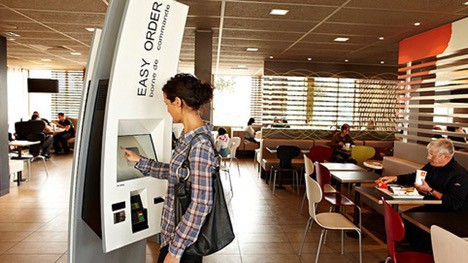Self-serve kiosks and digital signage are reinventing the retail and service industries as consumers not only become used to them but are in fact beginning to prefer them. It’s not hard to see why they’re growing in popularity: they cut down wait times and line ups; they allow customers more freedom to choose what they want without the pressure of waiting personnel; and they encourage interaction to learn about promotions and sales.
However, for kiosks to deliver a satisfactory ROI and improve customer satisfaction, they must be long-lasting and durable, and that means withstanding high levels of traffic, contamination, and even vandalism. Manufacturers like A D Metro supply electronics OEMs and resellers with touch screens built for public use in ATMs, QSRs, retail, and more, by adapting industrial-strength technologies. They offer industry-tough options like their Ultra Resistive technology, made from borosilicate glass, which can withstand repeated trauma such as vandalism and extreme temperatures, in addition to being waterproof, making them ideal for exterior ATMs and signage. For multi-touch capabilities and better optics, PCAP (Projected Capacitive) screen sensors are also available from A D Metro for use in points of sale, mobile computing, all-in-one PCs, and indoor kiosks.
As an OEM of electronics for retail, banking, QSR, or advertising, it’s important to understand why your clients are moving toward interactive kiosks now, so that you can design better products and source better suppliers. Below are the 4 leading reasons that self-service checkouts, kiosks, and interactive digital signage are replacing human personnel.
#1 Higher Sales and ROI: Interactive kiosks are not limited to points of sale; they can also be used as digital signage, assist customers in finding products, inform them of promotional deals, and encourage upsells. Without an interactive element, digital signage can become frustrating for consumers – digital signs like LED displays allow retailers to display many more messages than posters, but if a consumer notices a deal that engages them only to have wait through dozens more messages to see it again, it’s likely that customer has been lost. A touch screen allows the customer to interrupt the display of messages and find what it is that they’re looking for.
#2 Lower Costs: Replacing human personnel greatly reduces a retailer’s labor costs in the long run in addition to improving wait times for customers, meaning the reduction in staff leads to higher customer satisfaction.
#3 Efficiency: Kiosks free up labor from taking orders that enable your employees to focus on providing better, faster service and products. However, in certain conditions touch screens have to be durable enough to withstand high traffic and contaminants or liquids (especially in QSR), which is why retailers and QSR especially want devices with tough touch screens such as those made by A D Metro. After all, you can’t put your kiosk in a bowl of uncooked rice after someone spills coffee over it.
#4 Job Satisfaction: One of the side effects of more efficient service, where an interactive touch screen replaces a person in taking orders or processing payments, is increased job satisfaction among employees. Relieved of mundane tasks, retailers can reassign more challenging, satisfying, and productive work to their team, whether that’s helping customers make fashion decisions or focusing their efforts on making a better espresso.
Touch screens are changing the way brands relate to their customers; make sure your clients have technology that will stand up under pressure.
 Gearfuse Technology, Science, Culture & More
Gearfuse Technology, Science, Culture & More



